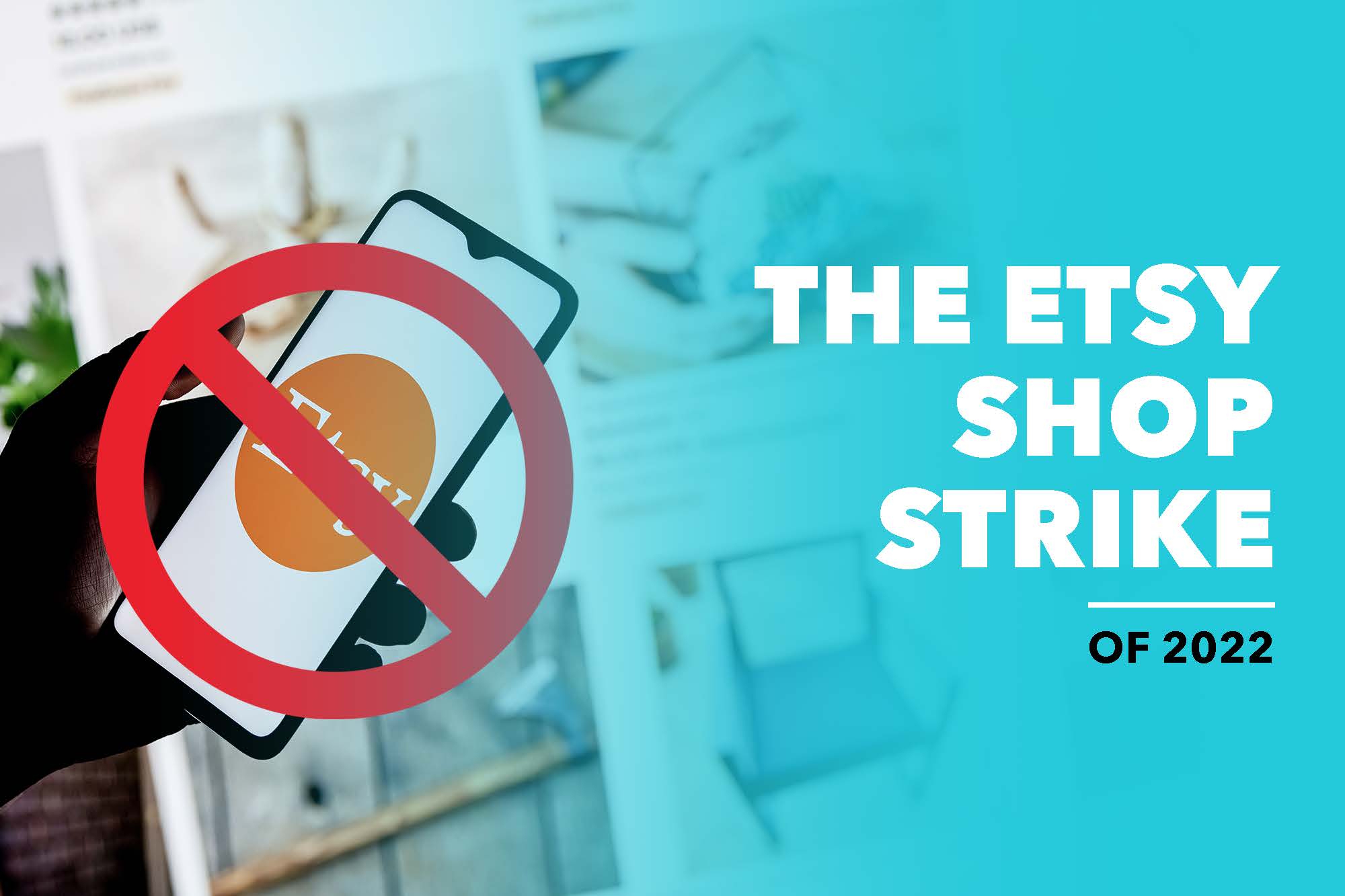Etsy Announces an Outrageous Price Hike
The revolution began on a place called Reddit (a massive collection of online forums dedicated to specific topics). February was nearing its end, and Kristi Cassidy was reeling from the news she had gotten the day before– Etsy, the eCommerce platform that she has been using since 2006 dropped the bomb that they were hiking their fees to all of their sellers by a whopping 30%. (To give you an idea of what a drastic jump the fees were, Etsy was charging its users 5% per sale as a “transaction fee.”)
Etsy is (in their own words) “a global online marketplace where people come together to make, sell, buy, and collect unique items.” Cassidy sells gothic wedding dresses on the platform, and a hike like that would have been catastrophic for her business and its margins. Not only that, but a hike that sizable was like a slap in the face to sellers who have been loyal to the platform for years.
The Idea of a Strike is Born
This is when Cassidy had a thought. She pondered “What would happen if on April 11, so many sellers put their shops on vacation mode that Etsy starts [freaking out].” Vacation mode is a function of the Etsy platform that allows sellers to put their shops on hold for a period of time. Cassidy’s idea as she put those thoughts into writing was that Etsy would have no choice but to negotiate with its sellers.
Cassidy posted her idea to Reddit, and it got traction. The post incited a weeklong seller strike on Etsy in which thousands of sellers participated. Beginning on April 11, 2022, many sellers put their shops into vacation mode, as a formal protest against the 30% jump in fees. There was also an online petition that outlined a list of the seller’s demands that had nearly 80,000 signatures in just a short amount of time.
Etsy’s Side of the Story
Of course, every story has two sides. To give you some more information on Etsy’s side of the coin, let’s start off with the fact that they have over 5 million sellers who have active stores on its platform. They are experiencing a surge in growth in the last year and a half for a few reasons, the largest of which was that during the COVID-19 pandemic many people were forced to purchase things online. Not only that, but Etsy has a strong reputation for personalized, artisanal, and handmade items. A lot of people turned to Etsy in search of face masks.
To give you an idea of the jump in popularity Etsy saw, let’s compare the year before the pandemic to the year during it. In 2019 Etsy sellers generated gross sales of $5 billion dollars. Then, during the pandemic, that number jumped up to $12 billion in 2021. As you can see, Etsy is making a good deal of money, and the 30% increase would have been a huge jump in cash flow.
Etsy claims that the revenue generated by the increased fees was going to be re-invested back into the company (at least that’s what they told their investors). The investors who heard the news (as well as other analysts) were understandably excited by the fee increase because with them came the promise of new features, infrastructures, and improvements. This would conceivably keep existing sellers happy and potentially draw new sellers to the platform. Analyst Seth Stiggens went on the record as saying: “We appreciate the concerns of the sellers. This is their livelihood. But the offset is the company is using this as a lever to reinvest back into the business. Our view is that it should ultimately lead to stronger market share gains.”
The Strike and the Petition Made a Difference
It’s unclear how much revenue Etsy lost from the strike, but the point was made clear, and the petition definitely had an impact. Not long after the petition gained traction, Ety’s Chief Operating Officer Raina Moskowitz made some public comments. Among other things, she tried to emphasize that the company is genuinely dedicated and “committed” to supporting its sellers and helping them be as successful as possible.
In an official statement, Moskowitz also said: “We are always receptive to seller feedback and, in fact, the new fee structure will enable us to increase our investments in areas outlined in the petition, including marketing, customer support, and removing listings that don’t meet our policies.”
Moskowitz went on to say “We are always receptive to seller feedback and, in fact, the new fee structure will enable us to increase our investments in areas outlined in the petition, including marketing, customer support, and removing listings that don’t meet our policies.”
This means that, according to Etsy, the new increase– which is only 6.5% instead of the whopping 30%– will allegedly go back into the platform and focus on the areas that sellers addressed as pain points within the petition. Time will tell.
Other Increases and Fees
To have a clearer picture of what’s going on, it’s important to not that Etsy charges its sellers other fees beyond the transaction fee. Here is a breakdown of the most prominent fees that sellers are paying (in addition to the transaction fee):
Offsite Ads Program Fees: If someone finds an Etsy store online after clicking an ad for the seller’s product, that seller is charged between 12% and 15%.
Shipping Fees: Though Etsy does allow for digital products, much of its sales involve physical products, which in turn require shipping to be paid. That makes sense right? Well, this fee isn’t just the amount that a customer will pay for shipping, it’s a 5% fee on top of that. This is called a “shipping transaction fee” and it is 5% of the total cost that a seller’s customer pays for shipping.
So for example, if a customer pays $10 shipping, you pay Etsy $0.50 cents.
Listing Fees: If you want to post your items on Etsy, it costs $0.20 cents per item that you list. For example, if a seller posted five items, it would cost them $1 one dollar.
Payment Processing Fees: Etsy charges a percentage of each item sold to cover payment processing fees. The fees vary from country to country, but are around 4% in most places (the lowest it gets is 3% in Australia, and the highest it gets is 6.5% in Turkey).
So as you can see there are already several costs in place when it comes to selling on Etsy. According to Marie Hart, an Etsy seller who creates pins, charms, and art on the platform, these fees are making things very difficult. She says “The recent transaction fee increase, along with the [additional fees], has made it harder for smaller creators to turn a profit and make their business sustainable.”
Sure some of these fees can seem quite small, but over time they begin to add up. As a thought exercise let’s do an extreme example.
Let’s say you sell a Handmade Thingee on Etsy for $16 dollars as a result of someone clicking on an advertisement. That would look something like the following.
This first example will be at the previous Etsy rate of 5%.
Transaction Fee: 5% ($0.60)
Offsite Ads Program Fee: 15% ($2.40)
Shipping Fee: Shipping is $12 ($0.60)
Listing Fee: ($0.20)
Payment Processing Fees: 4% (0.48)
—
Total Etsy Fees: $4.28
That would mean that for a $12 Handmade Thingee, you’re bringing in $7.72.
Now let’s take a look at what these numbers would have been if the transaction fees climbed to 30%.
This first example will be at the previous Etsy rate of 5%.
Transaction Fee: 30% ($3.60)
Offsite Ads Program Fee: 15% ($2.40)
Shipping Fee: Shipping is $12 ($0.60)
Listing Fee: ($0.20)
Payment Processing Fees: 4% (0.48)
—
Total Etsy Fees: $7.28
That would mean that for a $12 Handmade Thingee, you’re bringing in $4.72.
Now remember, many of these items are hand-crafted, and take quite a bit of time to make. We used a low-priced example, but as you can see, you’d have to sell three of these just to start scratching the hourly minimum wage in most places.
Will the Increase Truly Improve the Platform?
As we mentioned, the petition did work to some degree– while there was still an increase, it was 6.5% instead of 30%. However, it remains to be seen if this increase is going to truly go back into making improvements on the platform.
Consider that things aren’t looking too good for Etsy historically– that this isn’t the first increase that sellers experienced in the last five years. In 2018, Etsy bumped its transaction fees from 3.5% to 5%. In the nearly four years since the 2018 hike, Cassidy (who initiated the strike) states that the actual improvement have been minimal.
Something else that Etsy sellers specifically asked for on the petition was the ability to opt-out of some of the recent “improvements” that don’t seem to be in the best interest of the sellers overall. For example, some sellers would rather opt out of the Offsite Ads program and rely on having their items found organically or through their own promotion rather than pay 12% to 15%. Opting out of that program is not an option, however.
Another “improvement” that all sellers aren’t in love with is the new Star Seller program. While it seems like a good concept on paper, it puts a lot of stress on Etsy sellers and takes a measure of control away from them. The program essentially looks at a seller’s last three months to see if they qualify for a Star Seller badge (it rechecks on the first of each month, looking back at the last 90 days of a seller’s account). It focuses on things like:
- Orders and Sales: If you sell a certain amount within the review period (10 items)
- 5-Star Reviews: You have to have a sterling review history
- Shipping: You have to get orders to your customers in a certain amount of time
- Response Rate: You need to respond to someone within 24 hours
If you meet all of the requirements, Etsy favors your store over others, and awards you with a special badge. Not only that, but it gives you more chances to be featured on the platform and claims it will eventually lead to more sales.
Seems like a pretty fair system, right? Well, the issue is that you’re at the mercy of buyers now, and frankly not everyone is fair. Not only that, but here are some other major challenges that sellers are facing due to the Star Seller initiative.
After Christmas, many sellers were being hammered with 1-star to 3-star reviews due to late deliveries by various delivery services. This was in spite of the fact that the packages were sent out on time. In some instances, people were buying after the “will arrive before Christmas Date” listed.
Additionally, unless people update to the most recent version of the Etsy app, the highest rating available is 4-stars when it should be 5. This means that people are wrongfully getting 4-star reviews, and aren’t eligible for the Star Seller program as a result of a glitch in Etsy’s end.
So as you can see, sellers feel that if these are the kinds of “improvements” they can expect, they don’t want them. Many sellers have been vocal about the fact that they are skeptical that the increase will result in any meaningful changes that will actually benefit them, but only time will tell.
Etsy vs. Shopify: Choosing the Right Platform
This is a great question, and we’re going to give you all of the details you need to make this choice. In this section of the article, we’re going to pit Etsy against its biggest competitor, Shopify. We’ll show you the pros and cons of each one and give you the tools you need to make the best decision for your business. Let’s put these two eCommerce platforms head to head and see who comes out the winner.
What’s the Difference, Really?
It’s important to note that even though these two platforms may seem very similar at a glance, truthfully they are quite different. The first thing to consider is that Shopify is what would be more classically called a true “eCommerce platform” and Etsy (even though it is still categorized as eCommerce is really more of a marketplace.
For example, with Shopify, you can build your own fully functional online store and customize all of the details on your own web address. It has quite a few powerful eCommerce tools as well as a lot of apps you can add on for tons of functionality. When you use Shopify, you choose to be independent and can enjoy full control.
Shopify on the other hand, is a place where you sign up for an account on their site, and they house everything. They even call themselves a creative “marketplace” where you’re able to list your products for sale. A few key differences are that Etsy hosts and controls everything and gives its users only a fraction of the customization options that a Shopify store would have.
Etsy has tried to compete with Shopify by introducing its own website building platform called Etsy Pattern, but even at its affordable price point of $15 it just can’t compete with Shopify in terms of sheer usefulness and features.
Shopify Pros
For starters, Shopify lets you sell as many products as you want without any sort of limitations. You can sell physical products and get an app that lets you sell digital downloads as well, and there are no restrictions on what you can sell (and no fees to post products).
Additionally, Shopify has a reputation for being “easily scalable” which essentially means it is very easy to grow your store without much headache or hassle at all. Very small businesses can use the platform, but there are also massive, multi-million dollar, international companies that use it as well.
Shopify is also great for customization, and you can make your storefront’s appearance essentially anything you want and feature your branding. There are also themes and templates you can use for more customization– some are free, and some are paid.
Finally, as we mentioned, Shopify comes with a powerful set of eCommerce tools that are largely considered to be the best on the market today. By using the right tools and apps you can manage and grow your business. One of its most valuable, time-saving features is the ability to easily manage stock and inventory– it’s virtually automatic once you get everything set up properly.
Shopify Cons
Shopify isn’t without its cons. Remember those awesome apps we mentioned? While some of them are free, there are many of them that do cost money. If you add several paid apps on top of your monthly Shopify expenses, they can start to add up quickly– especially as you’re starting out and may not be making a ton of money.
Something else to consider is that Shopify isn’t a marketplace, which means that they aren’t going to send any traffic to your site. When it comes to Etsy, eBay, Amazon, and other marketplaces, there are users visiting these sites daily– that’s not the case with Shopify. Unless you’re bringing traffic to your own website, you won’t be making many (if any) sales.
Etsy Pros
As we mentioned, Etsy is a marketplace. This means that millions of people every month are on the platform which definitely can increase your chances of your store being found. In this model, any of your own marketing will just be on top of what Etsy is potentially already bringing you.
Also, we discussed fees above, but those are specific to each product sold. When it comes to using Etsy, there aren’t any monthly subscription fees associated with using their Standard plan. This can be helpful when you’re starting out because your initial investment into Etsy will be minimal.
Etsy is also super simple to use, and you can start an account and be off to the races in minutes. All you need are some products and some images, and you can be ready for selling on your first day.
Etsy Cons
As we mentioned in the portion of the article that covers the strike, there are quite a few fees associated with your individual item sales on Etsy. (Also, as we’ve seen, Etsy can increase these fees any time they want, which makes it tough to double down on them as a long-term solution.)
Ety’s simplicity is actually a double-edged sword– it’s quick and easy, but because of that, the customization options are very limited. For the most part, aside from your unique products and logo, your Etsy store will basically look just like everyone else’s. This can be challenging when your branding doesn’t fit the Etsy mold easily.
Finally, there are definitely restrictions on what you can sell on Etsy, it’s not as freeform as Shopify. They specify that you can only sell the following items:
- Vintage items (this is defined as anything that is 20+ years old)
- Craft supplies
- Handmade items and goods
Etsy vs. Shopify The Verdict
We’ll tell you upfront that for most companies, Shopify is going to be the clear winner.
While Etsy has a ton of organic traffic, it does tend to nickel and dime its sellers, and you’re at their mercy in many ways. Not only that, but many businesses are limited by Etsy’s categories. If your company isn’t selling handmade goods, craft supplies, or vintage items, you actually can’t sell on the platform.
Most businesses also already have a website or at least a domain name purchased. When you use Shopify, you can link your store to your own URL (like BuyMyStuff dot com, for example). For many businesses, an Etsy store wouldn’t look professional.
Shopify is also easier and more affordable to scale because they have monthly fees– but no individual transaction fees. This means that you’re not penalized for being successful (something that Etsy is arguably doing to their sellers).
As we mentioned earlier, Shopify is also an absolute beast when it comes to sales features and options. The amount of super useful and powerful apps out there is stunning and can suit businesses of all kinds.
Something else worth mentioning is that Shopify has customer support that (in our experience) is far superior and more in-depth compared to what Etsy is offering. Shopify’s support is 24/7 via phone and live chat (not to mention its social media, its forums, email support, and a large library of video tutorials). On their higher-paid plans, they also offer something called Advanced Specialist Support to handle any of the rare outlying and troublesome problems that may occur. Basically, if your site blows up at 2:00 a.m., Shopify is still there to help and can get you the info you need. When it comes Etsy, its support comes mostly from its community-based forum and its online help center. This means that at 2:00 a.m. you’d be dead in the water hoping you find the perfect help article.
The final verdict is this: pound for pound, Shopify is a much better platform than Etsy for selling overall. If your business is looking to grow and scale, and sell products that aren’t handmade, it’s no question.
But how can you get started on your Shopify journey?
Let Good Rep Media Help You With Your eCommerce
No matter which eCommerce platform you are thinking of choosing, we’d love to have a conversation with you and help you out.
Here at Good Rep Media, we focus 100% on helping small businesses with their marketing efforts, and we’re masters when it comes to eCommerce and Shopify.
We understand that as a small business taking on a task like starting an eCommerce site can seem impossible (or at least extremely challenging. When it comes to eCommerce, we use a transparent, proven process to get you the exact digital storefront you need.
Oh, and that’s another thing– we never take a cookie-cutter approach to anything we do. At no charge, we’d love to give you a free consultation about how Shopify could work for your business. We can help you out whether you already have a strategy or are just brainstorming your new store idea.
Our goal is to make powerful Shopify websites more accessible to businesses of all sizes by creating affordable, customizable marketing solutions. We’re not just thinking of you as “just another customer.” Instead, we’re excited to help you grow your small business as a partner and set ourselves apart from other service providers.
Give us a call today and let us show you how we can help you create the Shopify store of your dreams.




